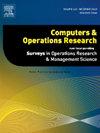最小最大多趟无人机定位弧线路由问题
IF 4.1
2区 工程技术
Q2 COMPUTER SCIENCE, INTERDISCIPLINARY APPLICATIONS
引用次数: 0
摘要
本文研究了最小最大多程无人机定位弧线路由问题(MM-MT-dLARP),这是一个结合了卡车和无人机的弧线路由问题。我们有一组线路(通常是弯曲的),需要无人机飞越这些线路来执行服务(例如检查)。卡车从一个仓库出发,每辆卡车都载有一架无人机,还有一组潜在的发射点,卡车可以在这些发射点发射并接收无人机。无人机的自主性有限,但可以进行多次飞行。我们考虑的是最小-最大目标,即必须将完成服务所需的时间(makespan)最小化。使用空中无人机而非地面车辆可以脱离网络:无人机可以通过任何一个点进入一条线路,只为该线路的一部分提供服务,然后通过另一个点离开,而无需遵循网络线路。这样可以找到更好的解决方案,但也增加了问题的难度。要解决这个问题,可以将 MM-MT-dLARP 实例数字化,用中间点数量有限的多边形链条来近似每条线路,并要求无人机只能通过这些中间点进出线路。这样,就得到了离散最小最大多行程定位弧形路由问题(MM-MT-LARP)的实例。本文提出了 MM-MT-LARP 的整数公式,证明了一些有效不等式族是松弛多面体的面诱导,并开发了一种基于强化公式的分支切割算法。该算法仅适用于线上无中间点的小实例。此外,我们还开发了一种 MM-MT-dLARP 的数学启发式算法,该算法结合了一个构造阶段、四个局部搜索程序(集成到一个可变邻域后裔算法中)以及一套用于选择中间点以改进解的规则。我们介绍了在一组随机生成的实例中获得的结果,这些实例最多涉及 6 个发射点和 88 条原始线路。本文章由计算机程序翻译,如有差异,请以英文原文为准。
The min max multi-trip drone location arc routing problem
This paper studies the Min Max Multi-Trip drone Location Arc Routing Problem (MM-MT-dLARP), an arc routing problem that combines trucks and drones. We have a set of lines (usually curved) that have to be flown over by drones to perform a service (inspection, for example). There is a depot from which the trucks leave, each one carrying a drone, and a set of potential launching points where the truck can launch and pick up the drone. Drones have limited autonomy, but they can make several flights. We consider a min–max objective, in which the makespan, or time necessary to complete the service, must be minimized. Using aerial drones instead of ground vehicles allows to travel off the network: drones can enter a line through any of its points, service only a portion of that line and then exit through another of its points, without following the lines of the network. This allows for finding better solutions but also increases the difficulty of the problem. This issue can be addressed by digitizing the MM-MT-dLARP instances, approximating each line by a polygonal chain with a finite number of intermediate points, and requiring that drones can only enter and exit a line through those intermediate points. Thus, an instance of a discrete Min Max Multi-Trip Location Arc Routing Problem (MM-MT-LARP) is obtained. Here, an integer formulation for the MM-MT-LARP is proposed, some families of valid inequalities are proved to be facet-inducing of a relaxed polyhedron, and a branch-and-cut algorithm based on the strengthened formulation is developed. This algorithm has only been applied to small instances without intermediate points on the lines. In addition, we have developed a matheuristic algorithm for the MM-MT-dLARP that combines a construction phase, four local search procedures integrated into a Variable Neighborhood Descent (VND) algorithm, and a set of rules for selecting intermediate points to improve the solutions. We present the results obtained on a set of randomly generated instances involving up to 6 launching points and 88 original lines.
求助全文
通过发布文献求助,成功后即可免费获取论文全文。
去求助
来源期刊

Computers & Operations Research
工程技术-工程:工业
CiteScore
8.60
自引率
8.70%
发文量
292
审稿时长
8.5 months
期刊介绍:
Operations research and computers meet in a large number of scientific fields, many of which are of vital current concern to our troubled society. These include, among others, ecology, transportation, safety, reliability, urban planning, economics, inventory control, investment strategy and logistics (including reverse logistics). Computers & Operations Research provides an international forum for the application of computers and operations research techniques to problems in these and related fields.
 求助内容:
求助内容: 应助结果提醒方式:
应助结果提醒方式:


